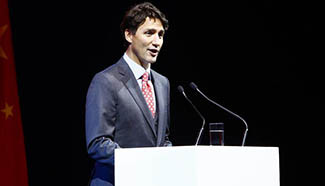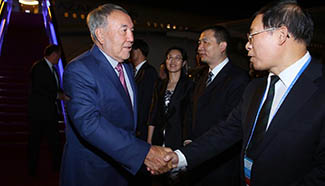BEIJING, Sept. 2 (Xinhua) -- The Chinese economy, an engine of the global economy with a relatively high growth rate, can provide experience for developing regions and countries, including Latin America.
On the eve of the Hangzhou G20 summit aimed at seeking a solution for the sluggish world economy, experts say that China's experience -- choosing a suitable development path, establishing special economic zones and investing in infrastructure and human capital -- can help some Latin American countries emerge from a difficult situation.
CHOOSING A SUITABLE DEVELOPMENT PATH
"It is the people of a country that are in the best position to judge the path of development they have chosen for themselves," Chinese President Xi Jinping told an audience at the Moscow State Institute of International Relations during a visit to Russia in March 2013.
China's development experience of more than three decades has shown that a country should not simply copy the prescriptions of Western countries; a one-size-fits-all approach isn't the answer.
In the 1980s, Latin American countries that fell deeply into a debt crisis accepted the prescriptions offered by the International Monetary Fund (IMF) and the World Bank, namely the Washington Consensus, which they hoped would end a bout of stagflation through neoliberal reforms highlighting privatization, liberalization and marketization.
The neoliberal policies were effective in the short term, with inflation being contained and a number of economies showing signs of recovery.
However, Western financial liberalization brought trouble. Extremely high systematic risks caused financial crises in Latin America, resulting in a "lost decade."
Furthermore, the risky privatization reform exacerbated the rich-poor divide with colossal social wealth occupied by very few people and gravely undermined social stability.
On whether neoliberalism is "oversold," three IMF economists -- Jonathan D. Ostry, Prakash Loungani and Davide Furceri -- reflected on the issue in an article published in June on the bloc's website.
"The link between financial openness and economic growth is complex," the article said. "Growth and risk-sharing benefits of capital flows depend on which type of flow is being considered; it may also depend on the nature of supporting institutions and policies."
"Although growth benefits are uncertain, costs in terms of increased economic volatility and crisis frequency seem more evident," it said.
"Since 1980, there have been about 150 episodes of surges in capital inflows in more than 50 emerging market economies...about 20 percent of the time, these episodes end in a financial crisis," it added.
Carlos Aquino, an East Asia expert with Peru's National University of San Marcos, said that failure in some Latin American countries and success in China have shown that choosing a development path that is catered to a specific country instead of copying the experience of others is the key to success.
ESTABLISHING SPECIAL ECONOMIC ZONES
Late Chinese leader Deng Xiaoping once described China's process of reform and modernization as being like a person crossing a river by feeling his way over the stones.
With such a pioneering spirit, China set up the first special economic zones in Shenzhen, Zhuhai, Shantou and Xiamen in 1980, exploring the possibilities of establishing a socialist market economy system and promoting comprehensive reform through institutional innovation in some areas.
Today's Shenzhen has grown from a border town of 30,000 people to a metropolis with a population of more than 10 million. Its gross domestic product (GDP) also increased from less than 200 million yuan (about 30 million U.S. dollars) in 1979 to 1.75 trillion yuan (about 260 billion dollars) in 2015.
With the expansion of high-tech companies such as Huawei, ZTE Corporation and Tencent and the settlement of hundreds of scientific research and development institutions, Shenzhen has rapidly turned into a modern, international and innovative "Silicon Valley" in China.
China's successful experience in developing special economic zones has set an example for Latin America especially for the resource-based countries, said Chaiyu, a researcher with the Institute of Latin American Studies under Chinese Academy of Social Sciences.
It is difficult for those countries to find a breakthrough for development as a relatively single economic development model and virtually unchanged state interest groups have led to strong market protectionism and poor investment facilitation.
Against the backdrop of the Latin American economic downturn, China can work with the continent in establishing special economic zones through promoting Chinese experiences and wisdom.
Alicia Giron, a researcher with the Institute of Economic Investigation of the National Autonomous University of Mexico, said gradual reforms that embrace the future are key for China's development.
Compared to Latin American countries, China's advantage is having clear development programs in the short, medium and long term, which helps promote ideas such as establishing special economic zones.
INVESTMENT IN INFRASTRUCTURE, HUMAN CAPITAL
McKinsey Global Institute estimated that between 1992 and 2011, China's investment in infrastructure was in the global lead, reaching 8.5 percent of its GDP.
In contrast, weak infrastructure and high logistics costs have impeded economic development in Latin America.
According to the Organization for Economic Cooperation and Development (OECD), logistics costs can reach as high as 18 to 35 percent of product value in Latin America while the average level in OECD members is only 8 percent.
Investment in infrastructure in Latin American countries is only about 3 percent of GDP and if they want to reach the level of East Asia, the percentage should increase to at least 6 percent, which means an additionally 30 billion dollars annually is required to improve infrastructure, said the Development Bank of Latin America.
A report from the UN Economic Commission for Latin America and the Caribbean said that due to a low level of education and laggard human capital, the possibility of facing severe operation problems for Latin American companies is 15 times higher than that of the Asia-Pacific counterparts.
Due to the lack of infrastructure and human capital, resource-rich Latin American countries failed to effectively transform their resources to industrial products; while Chinese exports have transformed from manufactured goods with low added value such as toys and clothing to those with high added value such as smart phones and cars, thanks to the great improvement in infrastructure and human capital, Aquino said.
Today China is supporting the development of infrastructure in Latin America. In 2014, during a visit to Latin America, President Xi announced a series of cooperative programs, including a 20-billion-dollar loan for infrastructure.
Additionally, a 30-billion-dollar special fund for promoting China-Latin America cooperation in production capacity and equipment manufacturing and a 10-billion-dollar fund for industrial cooperation will provide financing for infrastructure in the region.












